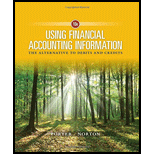
Using Financial Accounting Information
10th Edition
ISBN: 9781337276337
Author: Porter, Gary A.
Publisher: Cengage Learning,
expand_more
expand_more
format_list_bulleted
Question
Chapter 4, Problem 4.7.2E
To determine
Concept Introduction:
Prepaid insurance: It is the amount which is paid by the company in advance for the upcoming months. This amount is transferred to expense when expense is due for that period. Prepaid items are an asset account and are shown on asset side of
To State: The date whenthe company would renew its insurance policy.
Expert Solution & Answer
Trending nowThis is a popular solution!

Students have asked these similar questions
Please explain the correct approach for solving this financial accounting question.
Please provide the correct answer to this general accounting problem using valid calculations.
I am looking for the correct answer to this general accounting question with appropriate explanations.
Chapter 4 Solutions
Using Financial Accounting Information
Ch. 4 - Revenue Recognition The highway department...Ch. 4 - Prob. 4.2.1ECh. 4 - Prob. 4.2.2ECh. 4 - Prob. 4.2.3ECh. 4 - Prob. 4.3ECh. 4 - Prob. 4.4ECh. 4 - Prob. 4.5ECh. 4 - Prob. 4.6.1ECh. 4 - Prob. 4.6.2ECh. 4 - Prob. 4.6.3E
Ch. 4 - Prob. 4.6.4ECh. 4 - Prob. 4.7.1ECh. 4 - Prob. 4.7.2ECh. 4 - Prob. 4.8.1ECh. 4 - Prob. 4.8.2ECh. 4 - Prob. 4.8.3ECh. 4 - Prob. 4.8.4ECh. 4 - Prob. 4.8.5ECh. 4 - Prob. 4.9.1ECh. 4 - Working Backward: Depreciation Polk Corp....Ch. 4 - Prob. 4.10.1ECh. 4 - Prob. 4.10.2ECh. 4 - Prob. 4.10.3ECh. 4 - Prob. 4.10.4ECh. 4 - Prob. 4.11.1ECh. 4 - Prob. 4.11.2ECh. 4 - Prob. 4.11.3ECh. 4 - Prob. 4.12.1ECh. 4 - Prob. 4.12.2ECh. 4 - Prob. 4.12.3ECh. 4 - Prob. 4.13.1ECh. 4 - Prob. 4.13.2ECh. 4 - Prob. 4.13.3ECh. 4 - Prob. 4.14ECh. 4 - Prob. 4.15.1ECh. 4 - Prob. 4.15.2ECh. 4 - Prob. 4.15.3ECh. 4 - Prob. 4.15.4ECh. 4 - Prob. 4.15.5ECh. 4 - Prob. 4.16.1ECh. 4 - Prob. 4.16.2ECh. 4 - Prob. 4.16.3ECh. 4 - Prob. 4.17.1ECh. 4 - Prob. 4.17.2ECh. 4 - Prob. 4.18.1ECh. 4 - Prob. 4.18.2ECh. 4 - Prob. 4.18.3ECh. 4 - Prob. 4.19.1ECh. 4 - Prob. 4.19.2ECh. 4 - Prob. 4.20.1ECh. 4 - Prob. 4.20.2ECh. 4 - Prob. 4.20.3ECh. 4 - Prob. 4.21.1ECh. 4 - Prob. 4.21.2ECh. 4 - Prob. 4.22ECh. 4 - The Effect of Ignoring Adjustments on Net Income...Ch. 4 - Prob. 4.24ECh. 4 - Prob. 4.25ECh. 4 - Prob. 4.26.1MCECh. 4 - Prob. 4.26.2MCECh. 4 - Depreciation Expense During 2017, Carter Company...Ch. 4 - Depreciation Expense During 2017, Carter Company...Ch. 4 - Prob. 4.28.1MCECh. 4 - Prob. 4.28.2MCECh. 4 - Prob. 4.1.1PCh. 4 - Prob. 4.1.2PCh. 4 - Prob. 4.2.1PCh. 4 - Prob. 4.2.2PCh. 4 - Prob. 4.3PCh. 4 - Prob. 4.4.1PCh. 4 - Prob. 4.4.2PCh. 4 - Prob. 4.5.1PCh. 4 - Prob. 4.5.2PCh. 4 - Prob. 4.5.3PCh. 4 - Prob. 4.6.1PCh. 4 - Prob. 4.6.2PCh. 4 - Prob. 4.6.3PCh. 4 - Prob. 4.6.4PCh. 4 - Prob. 4.6.5PCh. 4 - Prob. 4.6.6PCh. 4 - Prob. 4.7.1PCh. 4 - Prob. 4.7.2PCh. 4 - Prob. 4.8MCPCh. 4 - Prob. 4.9.1MCPCh. 4 - Prob. 4.9.2MCPCh. 4 - Monthly Transactions, Adjustments, and Financial...Ch. 4 - Prob. 4.9.4MCPCh. 4 - Prob. 4.9.5MCPCh. 4 - Prob. 4.1.1AAPCh. 4 - Prob. 4.1.2AAPCh. 4 - Prob. 4.2.1AAPCh. 4 - Prob. 4.2.2AAPCh. 4 - Prob. 4.3AAPCh. 4 - Use of Account Balances as a Basis for Annual...Ch. 4 - Prob. 4.4.2AAPCh. 4 - Prob. 4.5.1AAPCh. 4 - Prob. 4.5.2AAPCh. 4 - Prob. 4.6.1AAPCh. 4 - Prob. 4.6.2AAPCh. 4 - Prob. 4.6.3AAPCh. 4 - Prob. 4.6.4AAPCh. 4 - Prob. 4.6.5AAPCh. 4 - Prob. 4.6.6AAPCh. 4 - Prob. 4.7.1AAPCh. 4 - Prob. 4.7.2AAPCh. 4 - Prob. 4.8AAMCPCh. 4 - Prob. 4.9.1AAMCPCh. 4 - Prob. 4.9.2AAMCPCh. 4 - Prob. 4.9.3AAMCPCh. 4 - Prob. 4.9.4AAMCP
Knowledge Booster
Learn more about
Need a deep-dive on the concept behind this application? Look no further. Learn more about this topic, accounting and related others by exploring similar questions and additional content below.Similar questions
- Can you solve this general accounting problem with appropriate steps and explanations?arrow_forwardPlease explain the solution to this financial accounting problem with accurate principles.arrow_forwardCan you help me solve this general accounting question using the correct accounting procedures?arrow_forward
- Please help me solve this general accounting problem with the correct financial process.arrow_forwardCan you solve this general accounting problem using appropriate accounting principles?arrow_forwardCan you help me solve this general accounting question using the correct accounting procedures?arrow_forward
- Can you help me solve this general accounting question using the correct accounting procedures?arrow_forwardI am trying to find the accurate solution to this financial accounting problem with the correct explanation.arrow_forwardI need help solving this general accounting question with the proper methodology.arrow_forward
arrow_back_ios
SEE MORE QUESTIONS
arrow_forward_ios
Recommended textbooks for you
- Principles of Accounting Volume 1AccountingISBN:9781947172685Author:OpenStaxPublisher:OpenStax College
 EBK CONTEMPORARY FINANCIAL MANAGEMENTFinanceISBN:9781337514835Author:MOYERPublisher:CENGAGE LEARNING - CONSIGNMENT
EBK CONTEMPORARY FINANCIAL MANAGEMENTFinanceISBN:9781337514835Author:MOYERPublisher:CENGAGE LEARNING - CONSIGNMENT

Principles of Accounting Volume 1
Accounting
ISBN:9781947172685
Author:OpenStax
Publisher:OpenStax College

EBK CONTEMPORARY FINANCIAL MANAGEMENT
Finance
ISBN:9781337514835
Author:MOYER
Publisher:CENGAGE LEARNING - CONSIGNMENT
7.2 Ch 7: Notes Payable and Interest, Revenue recognition explained; Author: Accounting Prof - making it easy, The finance storyteller;https://www.youtube.com/watch?v=wMC3wCdPnRg;License: Standard YouTube License, CC-BY